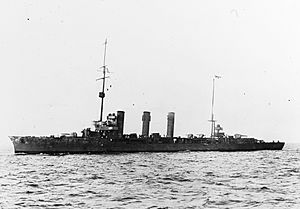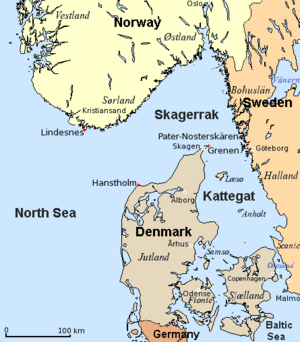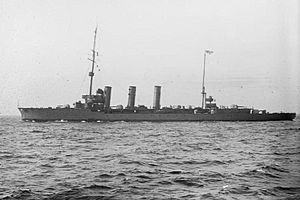Action off Lerwick facts for kids
The Action off Lerwick was a naval battle that happened on 17 October 1917 in the North Sea during the First World War. Two German light cruisers, the SMS Brummer and Bremse, attacked a group of twelve merchant ships. These ships were part of a regular convoy sailing from Norway to Britain.
The German ships sank nine neutral Norwegian, Danish, and Swedish merchant ships, along with their two British escorting destroyers, HMS Mary Rose and Strongbow. The battle took place near Lerwick in the Shetland Islands, Scotland.
British code-breakers had actually found out that the German ships were sailing. However, this important information was not quickly shared with the British naval commanders. This communication failure meant the British ships were not ready for the attack. Despite this, the commanders of the British destroyers were praised for their bravery. But some in the British Admiralty (the naval command) felt they should not have fought a stronger enemy force, as it left the merchant ships unprotected. The British called the German attack on neutral ships, without giving crews time to escape, an "outrage." The Germans, however, denied firing on survivors in the water, even though some crew members had gunshot wounds.
Quick facts for kids Action off Lerwick |
|||||||
|---|---|---|---|---|---|---|---|
| Part of The First World War | |||||||
 SMS Bremse, a Brummer-class cruiser, probably on the way to internment at Scapa Flow in 1918 |
|||||||
|
|||||||
| Belligerents | |||||||
| Commanders and leaders | |||||||
| Strength | |||||||
| 2 destroyers 2 naval trawlers 12 merchant ships |
2 light cruisers | ||||||
| Casualties and losses | |||||||
| Killed: 135 RN 36 neutral mariners Sunk: 9 freighters 2 destroyers |
|||||||
Contents
Why the Battle Happened
Shipping During Wartime
During World War I, Germany used U-boats (submarines) to sink many ships, including those from neutral countries. Britain tried to protect its ships and those of neutral countries by using escorted convoys. A convoy is a group of merchant ships traveling together with naval ships protecting them.
Neutral ships were very important to Britain. They helped bring in supplies. However, these neutral ships were often afraid to put guns on board. This meant they were more vulnerable to attacks than British ships, which often had defensive weapons and naval crews.
Norway's Role in the War

Norway was a neutral country, but it needed coal from Britain. In 1917, Britain and Norway made a deal called the Tonnage Agreement. Norway agreed to let Britain use many of its merchant ships. In return, Britain would make sure Norway received enough coal. This deal was kept quiet to avoid angering Germany.
To get coal to Norway and bring goods back, the British started a convoy system in April 1917. Ships would sail from the Humber Estuary in England to Lerwick in the Shetland Islands. From Lerwick, they would cross the North Sea to Norway.
These convoys were usually protected by two British destroyers and several armed trawlers. By July 1917, this system had been quite successful, with only a small percentage of ships lost. However, the convoys had to travel through waters where German surface ships could easily attack them. Also, because neutral ships were involved, it was hard for Britain to keep the convoy schedules a secret.
German Plans for Attack
The commander of the German High Seas Fleet, Admiral Reinhard Scheer, decided to attack these Scandinavian convoys. He hoped to scare neutral countries like Norway, who were helping Britain. He also wanted to force Britain to send more warships to protect the convoys. This would create a chance for the German fleet to fight the main British fleet (the Grand Fleet) when the British were weaker.
The Germans chose two new, fast, minelaying light cruisers, the Brummer and Bremse, for this mission. They were very fast and carried powerful guns. Their minelaying equipment was removed, and they were disguised to look like British ships. They also kept radio silence and had equipment to block British radio signals.
British Code-Breaking and Warnings
The British had a secret code-breaking unit called Room 40. On 15 October, Room 40 decoded a message from the Brummer. It suggested the ship was sailing north, possibly to lay mines. The Deputy Chief of the Naval Staff, Admiral Sir Henry Oliver, sent a message to Admiral David Beatty, the commander of the Grand Fleet, saying the Brummer should be stopped.
More decoded messages came in later. These messages suggested that the German ships might not be laying mines. For example, a German submarine reported many ships off Lerwick. Also, German orders told U-boats not to attack light cruisers unless they were sure they were British. This should have been a big clue. However, Admiral Oliver failed to pass on this new, crucial information to the ships at sea. He also didn't contact Admiral Beatty for 18 hours. By then, the convoy had already been attacked.
The Battle Begins
On the morning of 17 October, around 6:00 a.m., the British destroyer Strongbow spotted two unusual ships. The Strongbow tried to identify them, but the German ships opened fire with their powerful guns. The first shots hit Strongbow, damaging its steam-pipe and injuring many crew members. The ship was left dead in the water. Its radio was also knocked out before a distress call could be sent.
The other British destroyer, Mary Rose, also tried to send a radio signal as it moved towards the German ships. But the German Brummer jammed the signal. The German ships blocked every attempt by the British to send a distress call.
The commander of Strongbow, Lieutenant Commander Edward Brooke, made sure secret documents were thrown overboard. He then ordered the ship to be sunk. Survivors got into a life raft. The German cruisers continued to fire on Strongbow as it sank.
Meanwhile, the commander of Mary Rose, Lieutenant Commander Charles Fox, heard the gunfire. He thought a U-boat was attacking and turned his ship towards the sound. When he saw the German cruisers, he attacked them at high speed. The Mary Rose opened fire, but the German ships returned fire. Around 7:00 a.m., the Mary Rose was hit. Fox ordered "abandon ship," and eight men escaped on a life raft. Sadly, the German ships fired on this life raft and a motorboat carrying survivors from Strongbow.
After sinking Mary Rose, the Germans turned their attention to the merchant ships. They ignored the rules of war, firing at the merchant ships without giving their crews time to abandon them. For example, the Danish ship Margrethe stopped its engines, but was still fired upon as its lifeboats were being lowered.
The German ships sank five more merchant vessels. The two British and one Belgian merchant ships, along with the trawler P. Fannon, managed to escape. The trawler Elise returned later to rescue survivors, including 45 men from Strongbow. Survivors from Mary Rose reached Norway and were helped by lighthouse keepers.
Because the British ships couldn't send distress calls, British naval forces in the area continued to search for a minelayer, not knowing a major attack had happened. The Admiralty thought the German ships were still in port. It wasn't until late afternoon that news of the German attack reached British commanders. By then, the German ships were already far away, heading safely back to port.
What Happened Next
Casualties of the Battle
The battle resulted in many deaths. Of the 98 crew members on Mary Rose, 88 were killed. On Strongbow, 47 of the 86 crew members died. Many merchant sailors also lost their lives. For example, the Swedish ship H. Wikander lost 16 crew members, and the Norwegian ship Kristine lost 10. Some survivors reported that the Germans fired on them in the water, causing gunshot wounds. The Germans denied these accusations.
Changes to Convoys
After the attack, the Norwegian government protested to Germany, saying that Germany was violating the freedom of the seas. They argued that German attacks forced Norwegian ships to join convoys protected by countries at war with Germany.
The British Admiralty held a meeting to discuss what went wrong. They decided to change the Scandinavian convoy system. They proposed that convoys should sail from Methil Docks in Scotland, which was better equipped and closer to Swedish and Danish trade routes. This new route would bring convoys closer to German bases, so they would need stronger protection, like cruisers. The next Scandinavian convoy sailed from Norway to Lerwick just three days after the attack.
Orders of Battle
- Bremse, minelaying light cruiser (flagship)
- Brummer, minelaying light cruiser
- Mary Rose, destroyer (flagship)
- Strongbow, destroyer
- Elise, naval trawler
- P. Fannon, naval trawler
Convoy Ships
- British
- SS City of Cork
- SS Ben Cleugh
- Belgian
- SS Londonier
- Danish
- Margrethe: 1,243 Gross Register Tons (GRT), in ballast
- Norwegian
- Dagbjørg: 787 GRT, pit props
- Habil: 636 GRT, iron ore
- Silja: 1,231 GRT, pit props
- Sørhaug: 1,007 GRT, general merchandise
- Kristine: 568 GRT, wood pulp
- Swedish
- Visbur: 962 GRT, general merchandise
- H. Wicander: 1,256 GRT, cargo not known
- Stella; 836 GRT, iron ore, paper pulp
See Also
Images for kids
-
Chart of the Skagerrak





